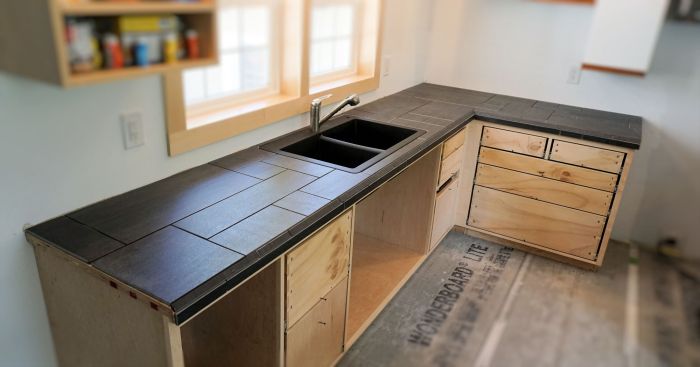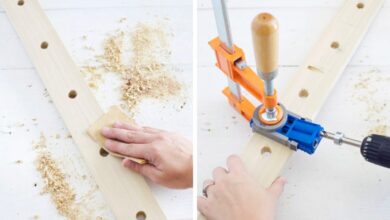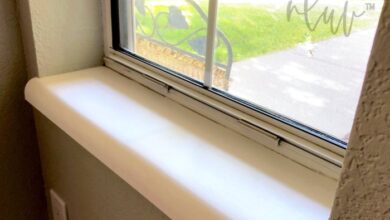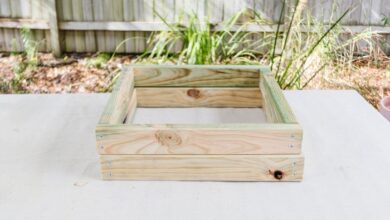
Tiled countertop diy no saw required – Tiled countertop DIY: No Saw Required – sounds impossible, right? But it’s not! This project allows you to transform your kitchen or bathroom with a stunning new countertop without the intimidating task of cutting tiles. With pre-cut tiles or tile sheets, you can achieve a professional-looking finish that’s both stylish and budget-friendly.
This DIY project is perfect for anyone who wants to give their home a fresh look without the hassle of complex tools or specialized skills. We’ll guide you through every step, from choosing the right tiles to sealing your beautiful new countertop.
Tile Countertop DIY Without a Saw

Creating a tile countertop without a saw might seem like a daunting task, but it’s actually quite achievable. This approach offers a less intimidating and potentially safer way to bring your dream kitchen or bathroom design to life. It also opens up opportunities to use a wider range of tile sizes and shapes, which can add a unique touch to your project.
Materials Needed for a Tile Countertop DIY Project
The materials needed for a tile countertop project without a saw are similar to those used in traditional tile installations. However, some adjustments might be required to accommodate the use of pre-cut tiles.
- Tile:Choose pre-cut tiles that fit your design and countertop dimensions. Consider using mosaic tiles, which are typically small and come in pre-assembled sheets, eliminating the need for cutting.
- Thinset Mortar:This adhesive is used to bond the tiles to the countertop substrate. Ensure you choose a thinset mortar specifically designed for tile countertops.
- Grout:Grout fills the gaps between tiles, creating a seamless and water-resistant finish. Select a grout color that complements your tile choice.
- Countertop Substrate:This is the base layer onto which the tiles are applied. Plywood or cement board are common choices. Ensure the substrate is level and strong enough to support the weight of the tiles.
- Backer Board:A layer of water-resistant backer board is often installed over the countertop substrate to create a barrier against moisture and ensure a durable finish.
- Tools:You’ll need a few basic tools, including a trowel, grout float, sponge, tile spacers, and a level.
Steps Involved in a Tile Countertop DIY Project
The process of creating a tile countertop without a saw involves several key steps that ensure a successful and durable finish.
- Prepare the Countertop Substrate:Ensure the countertop substrate is clean, level, and structurally sound. This step is crucial for a smooth and even tile installation.
- Install Backer Board:If required, install a layer of backer board over the countertop substrate. This provides a water-resistant barrier and creates a solid base for the tiles.
- Apply Thinset Mortar:Spread a thin layer of thinset mortar onto the countertop substrate using a trowel. Ensure the mortar is evenly distributed and adheres to the substrate.
- Install Tiles:Carefully place the pre-cut tiles onto the thinset mortar, ensuring they are level and evenly spaced. Use tile spacers to maintain consistent gaps between the tiles.
- Allow Mortar to Cure:Let the thinset mortar cure according to the manufacturer’s instructions. This ensures a strong bond between the tiles and the substrate.
- Apply Grout:Once the mortar has cured, apply grout to fill the gaps between the tiles. Use a grout float to spread the grout evenly and remove excess material.
- Clean and Seal:Clean the grout lines with a damp sponge to remove any excess grout. Once the grout has cured, seal the tiles and grout to protect them from stains and moisture.
Choosing the Right Tiles: Tiled Countertop Diy No Saw Required

Choosing the right tiles is crucial for a beautiful and durable countertop. You want tiles that are both aesthetically pleasing and functional, able to withstand the wear and tear of everyday use. This section will guide you through selecting the right tiles for your countertop project.
Types of Tiles for Countertops, Tiled countertop diy no saw required
The type of tile you choose will depend on your style and budget. Here are some popular options:
- Ceramic tilesare a popular choice for countertops due to their durability, affordability, and wide variety of colors and patterns. They are easy to clean and maintain. Examples include porcelain, glazed, and unglazed ceramic tiles.
- Porcelain tilesare a type of ceramic tile that is known for its durability and water resistance. It is often used in high-traffic areas like kitchens and bathrooms.
- Natural stone tiles, such as granite, marble, and slate, offer a unique and elegant look. They are durable and heat-resistant, making them ideal for countertops. However, they can be more expensive than ceramic tiles and require more maintenance.
- Glass tilesadd a modern and sophisticated touch to countertops. They are available in various colors and textures, making them a great option for creating a unique design. Glass tiles are generally less durable than ceramic tiles and can be more susceptible to scratches.
- Quartz tilesare a relatively new option for countertops. They are engineered stone, combining natural quartz with resin and pigments. Quartz tiles are durable, non-porous, and stain-resistant, making them a good choice for busy kitchens. They are also available in a wide range of colors and patterns.
Tile Size and Shape
The size and shape of your tiles will impact the overall look of your countertop. Consider the following:
- Large tiles(12×12 inches or larger) create a clean and modern look, minimizing grout lines and making cleaning easier. They are a good choice for larger countertops.
- Small tiles(4×4 inches or smaller) add visual interest and can create a more traditional look. They can also be used to create intricate patterns and designs.
- Mosaic tilesare small tiles that are often used to create decorative accents or patterns. They can be used in combination with larger tiles or on their own.
- Rectangular tilesare a classic choice for countertops. They can be laid in a traditional brick pattern or in a more contemporary herringbone pattern.
- Square tilesare a versatile option that can be used in various layouts, from traditional to modern.
Determining Tile Quantity
To determine the quantity of tiles needed for your countertop, you’ll need to measure the area of your countertop. Here’s a step-by-step guide:
- Measure the length and width of your countertop. For rectangular countertops, multiply the length by the width to get the total area. For countertops with irregular shapes, break them down into smaller rectangular sections and measure each section individually.
- Add 10% to 15% to the total areato account for waste and cuts. This will ensure you have enough tiles to complete your project.
- Calculate the number of tiles neededby dividing the total area by the area of each tile. For example, if your countertop area is 10 square feet and your tiles are 1 square foot each, you will need 10 tiles. Remember to add the additional percentage for waste and cuts.
It’s always better to overestimate than underestimate your tile needs. You can always return unused tiles, but it’s difficult to find matching tiles if you run out.
Tiled countertops are a great way to add a touch of personality to your kitchen, and with the right tools and techniques, you can achieve a professional-looking finish without needing a saw. Just like Canadian North Resources is committed to strengthening community engagement and consultation for the exploration and development of the Ferguson Lake project, a collaborative approach is key to successful DIY projects.
So, grab your tile cutter and get ready to transform your kitchen into a beautiful and functional space.
Thinking about a tiled countertop DIY but worried about the saw? Don’t fret! There are amazing options out there that don’t require any cutting. I recently saw a pink and white kitchen makeover before after that used pre-cut tiles, and the results were stunning.
I’m sure you can find a similar solution for your countertop project too, making your kitchen a dream without any saw-wielding stress.
Tiled countertops are a great way to add a touch of personality to your kitchen, and you don’t need a saw to get the job done! There are tons of great DIY tile projects out there, like using leftover tiles to create a stunning accent wall or even making your own personalized photo pillow, like this one I found here.
And once you’ve got your new countertop in place, don’t forget to add some finishing touches like a new backsplash or some fun kitchen accessories.






